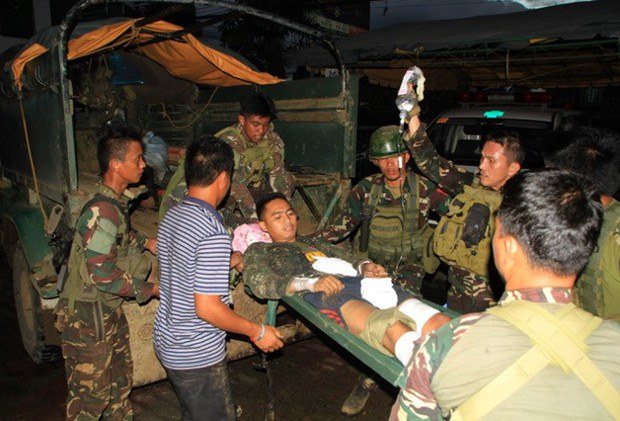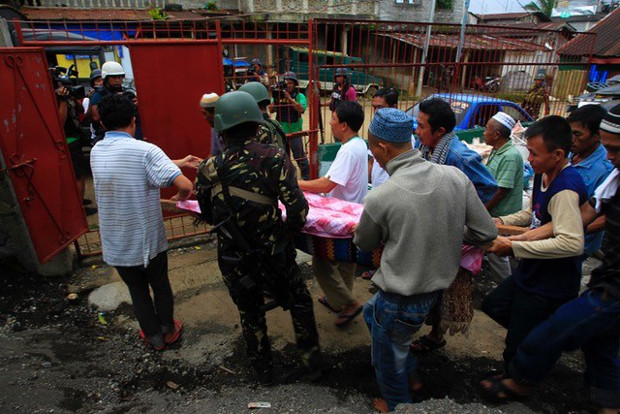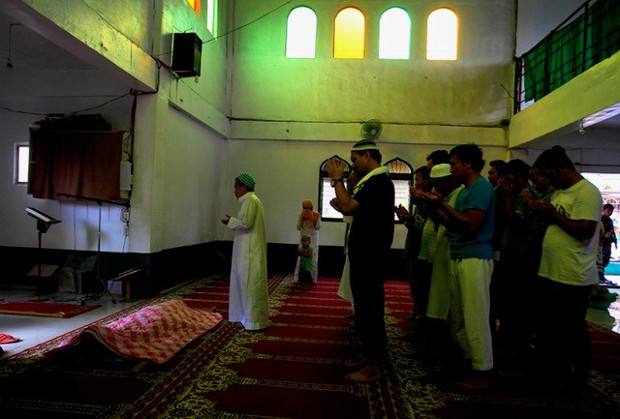Philippines Aims to Raise Flag in Marawi by Next Week
2017.06.09
Marawi, Philippines
 Soldiers assist one of 16 Philippine Marines who were wounded in a gunbattle with Islamic State-linked militants in the southern city of Marawi, June 9, 2017.
Soldiers assist one of 16 Philippine Marines who were wounded in a gunbattle with Islamic State-linked militants in the southern city of Marawi, June 9, 2017.
The Philippine military vowed Friday to raise the country’s flag within a few days across the southern city of Marawi, where troops have been battling Islamic State-linked militants during nearly three weeks of sustained fighting.
The enemy force had been weakened and the fighting confined to just three villages in Marawi, military spokesman Brig. Gen. Restituto Padilla told reporters. Marawi, a once vibrant Islamic city in the south, has become a wasteland of pockmarked buildings through battles that have killed almost 200 people and displaced tens of thousands of residents since May 23.
“The chief of staff made an announcement that by Monday, we can freely wave our flags in every corner of Marawi,” Padilla said in Manila, referring to Gen. Eduardo Año. “And we're working feverishly to do that.”
The Philippines marks its 119th Independence Day from Spain on Monday and raising the flag in Marawi on that day would be symbolic to show that the government has retained control after almost three weeks of intense fighting with extremists, he said.
Padilla said the military carried on with its offensives on Friday and “we are confident our troops are gaining important headway inside these areas.”
The Philippine military also said Friday that it had asked the social media network Facebook to shut down at least 63 accounts allegedly used by members or supporters of the IS-linked Maute gang to spread propaganda and misinformation about the battles in and around Marawi.
The gang is one of two IS-linked groups backed by foreign militants who have been fighting Philippine government forces while seizing and holding onto parts of the city. Fighters from Indonesia, Malaysia and Singapore are among the foreigners, according to Philippine officials.
The military said it had identified that those Facebook accounts were being used by militants and their sympathizers under falsified names, reports said.
“They are spreading lies, they are spreading misinformation and they are creating more problems in our fight against the terrorists,” Army spokesman Lt. Col. Jo-Ar Herrera told a news conference in Marawi City, according to Reuters.
Teen killed
On Thursday, dozens of civilians crawled out of the rubble during a lull in fighting, but hundreds are still believed to be trapped in three villages where the military focused its combat operations against members of the Abu Sayyaf and Maute groups.
While Padilla said the “world of terrorists” in Marawi was growing smaller by the day, violence still affected civilians.
On Friday, a 15-year-old boy was killed by sniper fire to the head as he prayed at a mosque in an area that had earlier been cleared by security forces, according to police who declined to release the victim's name because he was a minor.
It could not be immediately determined why he was targeted, but his death underscored that the gunmen were still capable of inflicting damage even from afar, officials said

Troops and locals carry the remains of Abdila Masid, 15, who was killed by sniper fire from a Maute militant while he was praying inside a mosque in Marawi, June 9, 2017. [Mark Navales/BenarNews]
Padilla said hoisting the Philippine flag in every corner of Marawi on Monday would also mean that every armed element in the city was either “neutralized, targeted or cleared.”
He said authorities believed the siege would be over soon because there was less enemy fire and enemy activity in certain areas of the city had diminished.
“The volume of fire coming from the enemy side is not as much as it was before,” he said. “There are areas where so much enemy activity was monitored (previously), but now seems to have dwindled and sniper fire has been very selective.”
Fighting erupted on May 23, when troops and police moved in to arrest Abu Sayyaf leader Isnilon Hapilon, the acknowledged head of the local Islamic State militants. But troops were surprised when they were met by heavy enemy fire from the previously negligible Maute group.
The gunmen spread across the city of 200,000, burning and looting and engaging the troops in running gun battles. They are still believed holding more than 200 hostages, including a Catholic priest, who has appealed for the government to cease its bombing runs.
Cellular phone videos that were recovered by the military and since declassified showed that the Marawi attack was planned, with Hapilon and the leaders of the Maute gang plotting their attacks.
The government has placed a bounty of 10 million pesos (U.S. $202,500) for the capture or killing of Hapilon. Several people linked to the Maute group had also been arrested after slipping out of Marawi, including Cayamora Maute, the clan patriarch.
Officials said that almost 200 people had lost their lives, including 39 soldiers and 20 civilians. The rest were militants.
Civilian rescue groups in Marawi had raised fears of a protracted fighting, with the military earlier acknowledging that the gunmen had a mastery of the terrain. Officials also discovered tunnels that indicated the gunmen had planned escape routes.
“This planned attack that we thwarted may lead to more destruction in Marawi and to more deaths,” Padilla said of the attack.
“And in the course of time, while they are preparing for that, they may have built up this cache of firearms,” he said.
As for the return of the city residents, Padilla said authorities would give the signal once it was safe to go back to their homes. He said the military would assist in Marawi’s reconstruction and rehabilitation efforts.

Relatives of Abdila Masid, a teenager slain by sniper fire, pray during last rites for him in Marawi, June 9, 2017. [Mark Navales/BenarNews]







